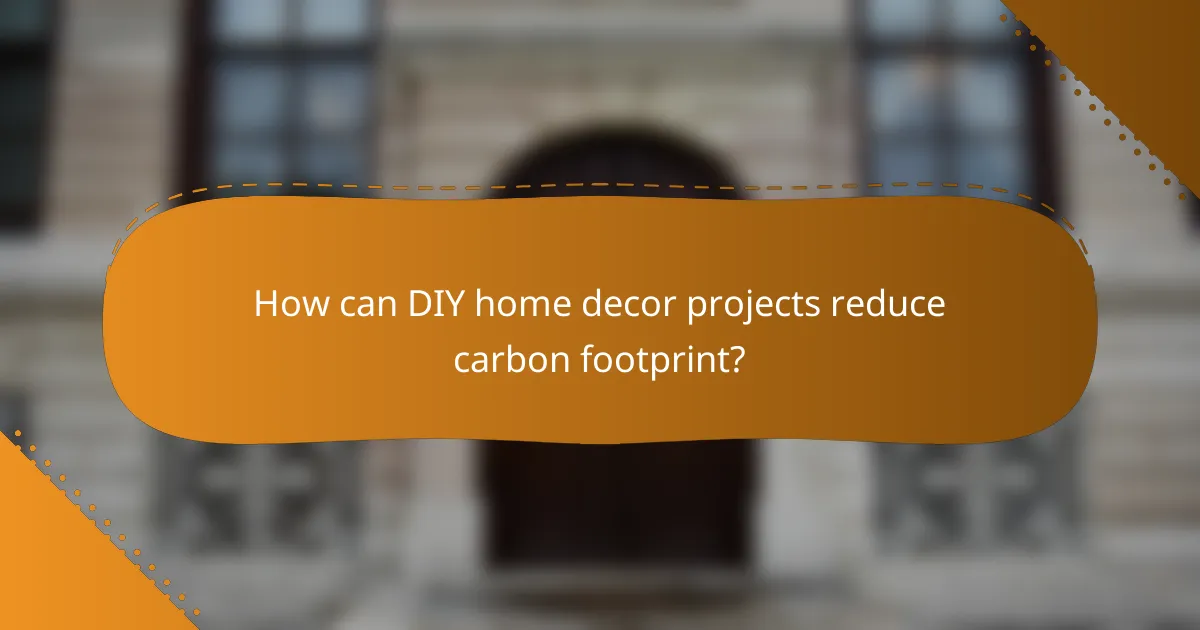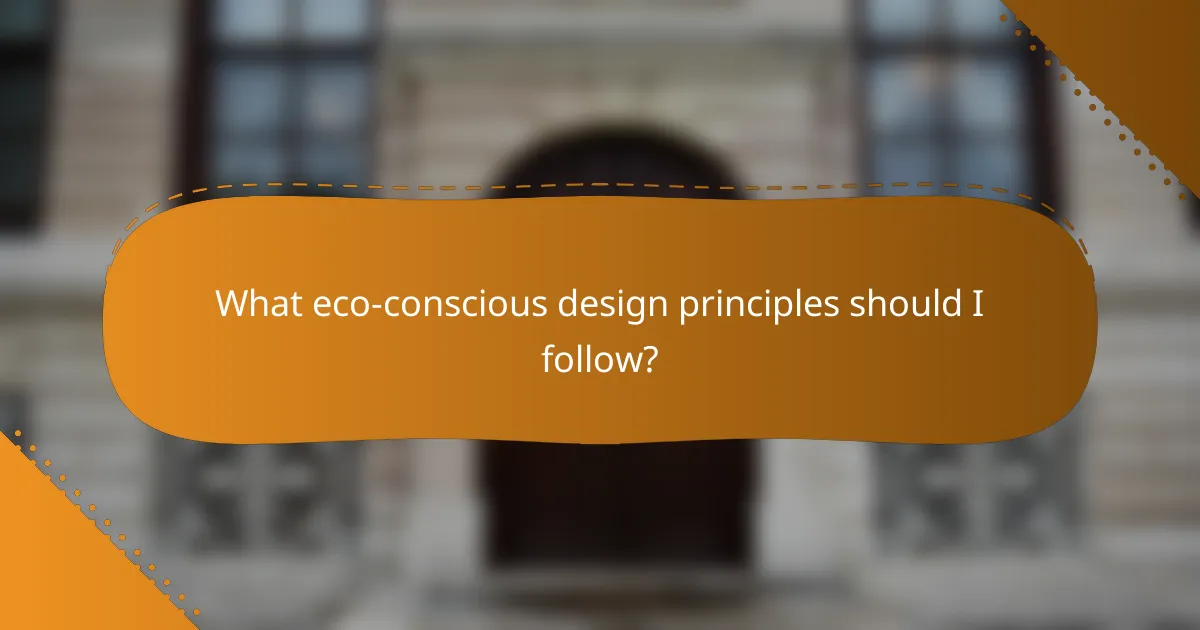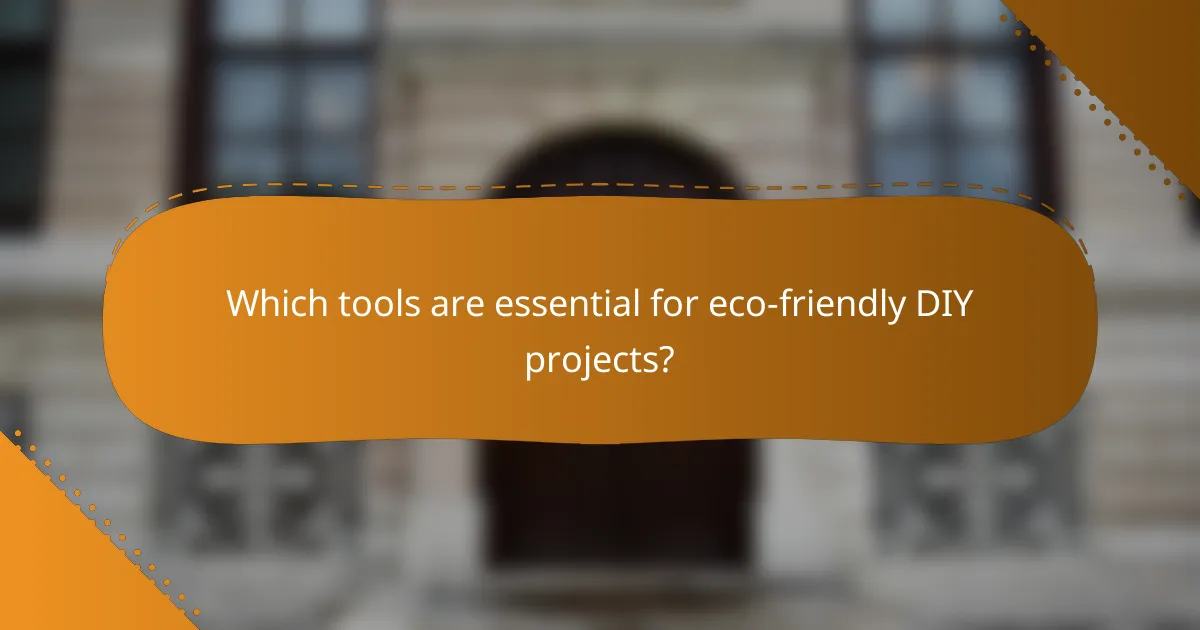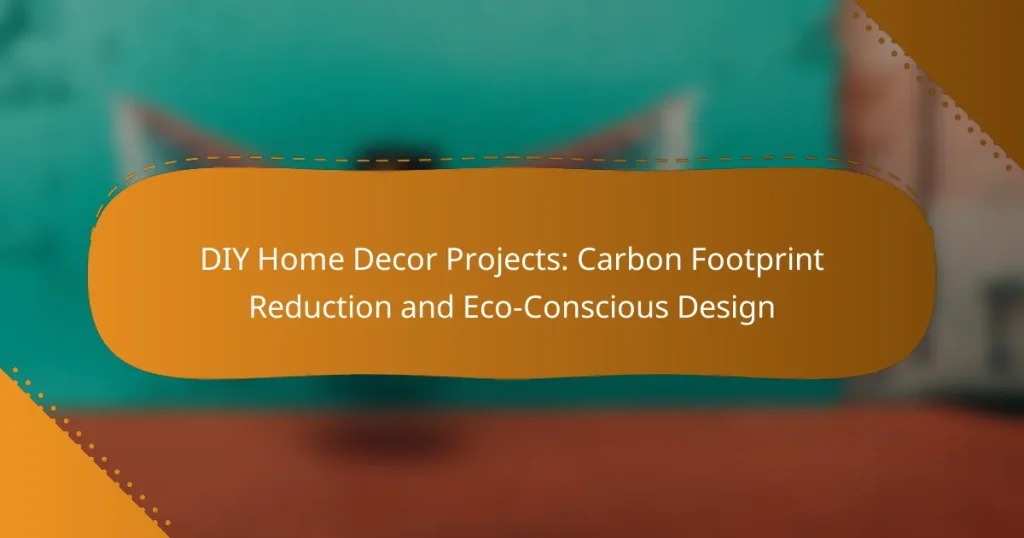Engaging in DIY home decor projects not only allows you to personalize your space but also plays a vital role in reducing your carbon footprint. By embracing sustainable practices and materials, such as upcycling and energy-efficient designs, you can create beautiful interiors that reflect your eco-conscious values. With the right tools and a focus on minimalism and natural elements, you can transform your home while making a positive impact on the environment.

How can DIY home decor projects reduce carbon footprint?
DIY home decor projects can significantly lower your carbon footprint by utilizing sustainable practices and materials. By focusing on upcycling, natural resources, energy efficiency, and eco-friendly products, you can create stylish spaces while minimizing environmental impact.
Upcycled furniture
Upcycling furniture involves repurposing old or discarded items into new, functional pieces. This practice reduces waste and the demand for new materials, which often require significant energy to produce. For instance, transforming an old wooden pallet into a coffee table not only saves resources but also adds character to your home.
When upcycling, consider local thrift stores or garage sales for unique finds. Always check the condition of the items and ensure they can be safely restored or modified. A fresh coat of paint or new hardware can breathe new life into an outdated piece.
Natural materials
Using natural materials in your decor helps reduce reliance on synthetic products that can harm the environment. Wood, bamboo, cork, and stone are renewable resources that offer durability and aesthetic appeal. For example, bamboo furniture is not only stylish but also grows rapidly, making it a sustainable choice.
When selecting natural materials, look for those sourced from sustainable practices, such as FSC-certified wood. This ensures that the materials are harvested responsibly, supporting both the environment and local communities.
Energy-efficient lighting
Energy-efficient lighting, such as LED bulbs, significantly lowers energy consumption and reduces your carbon footprint. These bulbs use up to 80% less energy than traditional incandescent bulbs and last much longer, making them a cost-effective choice over time.
To maximize energy efficiency, consider installing smart lighting systems that allow you to control brightness and timing. This can further reduce energy use and enhance your home’s ambiance.
Indoor plants
Incorporating indoor plants into your decor not only beautifies your space but also improves air quality by absorbing carbon dioxide and releasing oxygen. Plants like snake plants and pothos are low-maintenance options that thrive indoors.
When choosing indoor plants, consider their light and water requirements to ensure they flourish in your home environment. Additionally, using pots made from recycled materials can further enhance your eco-friendly decor.
Low-VOC paints
Low-VOC (volatile organic compounds) paints are a healthier choice for your home, as they emit fewer harmful chemicals compared to traditional paints. This not only benefits your indoor air quality but also reduces environmental pollution during production and application.
When selecting low-VOC paints, look for certifications such as Green Seal or the EPA’s Safer Choice label. These indicators ensure that the products meet strict environmental standards while providing a wide range of color options for your projects.

What eco-conscious design principles should I follow?
To create eco-conscious designs, focus on sustainable materials, minimalism, and biophilic elements. These principles help reduce your carbon footprint while enhancing the beauty and functionality of your home.
Sustainable sourcing
Sustainable sourcing involves selecting materials that are renewable, recycled, or responsibly harvested. Look for products made from bamboo, reclaimed wood, or recycled metals, which can significantly lower environmental impact.
When purchasing, check for certifications like FSC (Forest Stewardship Council) or Cradle to Cradle, which indicate responsible sourcing practices. Local sourcing can also reduce transportation emissions, so consider buying from nearby suppliers.
Minimalism
Minimalism emphasizes simplicity and functionality, which can lead to less waste and a smaller carbon footprint. By choosing fewer, high-quality pieces, you can create a clean aesthetic that avoids clutter and reduces the need for excess materials.
Incorporate multi-functional furniture and decor to maximize space and utility. This approach not only enhances your living environment but also encourages mindful consumption and reduces the urge to frequently buy new items.
Biophilic design
Biophilic design connects indoor spaces with nature, promoting well-being and sustainability. Incorporating natural elements like plants, natural light, and organic shapes can enhance air quality and create a calming atmosphere.
Consider adding indoor plants, using natural light through large windows, or selecting furniture that mimics natural forms. This approach not only improves aesthetics but also fosters a healthier living environment, benefiting both you and the planet.

Which tools are essential for eco-friendly DIY projects?
Essential tools for eco-friendly DIY projects include a mix of hand tools, power tools, and eco-friendly adhesives. These tools help minimize waste and reduce environmental impact while allowing you to create sustainable home decor.
Hand tools
Hand tools are fundamental for eco-friendly DIY projects as they often require less energy and produce minimal waste. Common hand tools include hammers, screwdrivers, saws, and pliers, which can be used for various tasks without relying on electricity.
When selecting hand tools, consider investing in high-quality, durable options that can last for years. Look for tools made from sustainable materials, such as bamboo or recycled metals, to further reduce your carbon footprint.
Power tools
Power tools can enhance efficiency in eco-friendly DIY projects but should be chosen carefully to minimize environmental impact. Opt for battery-operated or energy-efficient models that consume less electricity and have a lower carbon footprint compared to traditional corded tools.
Examples of eco-friendly power tools include cordless drills, electric saws with energy-saving features, and sanders that utilize low-VOC (volatile organic compounds) technology. Always check for energy ratings and certifications to ensure you are making a sustainable choice.
Eco-friendly adhesives
Eco-friendly adhesives are crucial for sustainable DIY projects, as they reduce harmful emissions and promote healthier indoor air quality. Look for adhesives that are water-based, low-VOC, or made from natural materials like plant resins.
Common eco-friendly adhesive options include PVA (polyvinyl acetate) glue, natural rubber adhesives, and biodegradable options. When using adhesives, ensure proper ventilation and follow manufacturer guidelines to maximize safety and effectiveness.

What are the costs associated with eco-conscious home decor?
The costs of eco-conscious home decor can vary widely based on materials, design choices, and project scale. While some options may have higher upfront expenses, many are designed to save money and reduce environmental impact over time.
Budget-friendly options
Eco-conscious home decor doesn’t have to break the bank. Many budget-friendly options include upcycling old furniture, using reclaimed wood, or choosing low-VOC paints. These choices not only save money but also minimize waste and reduce your carbon footprint.
Consider shopping at thrift stores or online marketplaces for second-hand items. You can often find unique pieces that can be easily refurbished, allowing you to create a personalized space without significant costs.
Long-term savings
Investing in eco-friendly decor can lead to long-term savings on energy and maintenance costs. For example, energy-efficient lighting and appliances may have higher initial prices but can significantly lower utility bills over time.
Additionally, using durable, sustainable materials can reduce the need for replacements, saving both money and resources. For instance, bamboo flooring may cost more upfront but lasts longer than cheaper alternatives, making it a wise investment.
Investment in quality materials
Choosing high-quality, eco-friendly materials often requires a larger initial investment but pays off in durability and sustainability. Materials like certified hardwood, recycled glass, or organic textiles may be pricier but contribute to a healthier home environment.
When selecting materials, look for certifications such as FSC (Forest Stewardship Council) for wood products or GOTS (Global Organic Textile Standard) for fabrics. These certifications ensure that the materials meet strict environmental and social standards, providing peace of mind alongside quality.

How can I find inspiration for sustainable DIY decor?
Finding inspiration for sustainable DIY decor involves exploring various resources that focus on eco-friendly materials and designs. Look for platforms that showcase innovative projects, local workshops that teach sustainable practices, and blogs dedicated to green living for fresh ideas.
Online platforms
Online platforms such as Pinterest, Instagram, and specialized DIY websites are excellent sources for sustainable decor inspiration. Search for hashtags like #SustainableDIY or #EcoFriendlyDecor to discover projects that utilize recycled materials or natural elements.
Many platforms allow users to share their own projects, providing a community-driven approach to finding ideas. Consider saving your favorite designs to a digital board for easy reference during your own projects.
Local workshops
Local workshops often provide hands-on experience and guidance in creating sustainable decor. Check community centers, craft stores, or environmental organizations for upcoming classes that focus on eco-conscious design techniques.
Participating in these workshops not only enhances your skills but also connects you with like-minded individuals who share your passion for sustainability. Look for workshops that emphasize the use of local and reclaimed materials to further reduce your carbon footprint.
Eco-friendly blogs
Eco-friendly blogs are rich resources for sustainable DIY decor ideas, offering tutorials, tips, and product recommendations. Many bloggers focus on upcycling, using natural materials, and minimizing waste in their projects.
Follow blogs that align with your aesthetic preferences and values. They often provide step-by-step guides, making it easier to replicate their projects while ensuring you maintain an eco-conscious approach.


